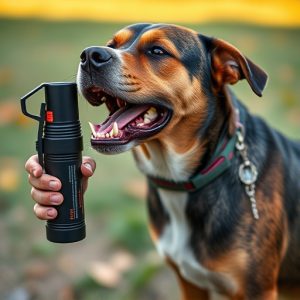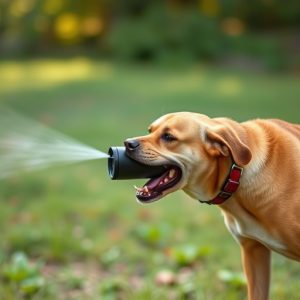Mastering Dog Spray: Safe, Effective Training Techniques & Alternatives
Dog spray (mace spray for dogs) is a non-lethal deterrent for aggressive canine behavior, requiring…….
Dog spray (mace spray for dogs) is a non-lethal deterrent for aggressive canine behavior, requiring controlled environment training with basic commands and consistent timing. Select natural, mild ingredients like capsaicin to avoid harsh chemicals. Use positive reinforcement alongside spray applications, focusing on desired behaviors ("sit", "stay") as conditional responses to unwanted actions, such as jumping on guests. Proper techniques view the spray as a pause button for recalibration, avoiding primary punishment to prevent fear or aggression. Humane alternatives like clicker training, verbal reinforcement, treats, and affection foster stronger bonds and teach effectively without harmful methods.
“Unleash effective dog training with the power of proper mace spray techniques. This comprehensive guide explores how this safe, non-harmful deterrent can transform your canine’s behavior. From understanding its efficacy to choosing the right spray and mastering implementation, we delve into proven methods for positive reinforcement. Discover alternatives to traditional spray training while ensuring a harmonious bond with your furry friend. Enhance your dog’s discipline journey with these expert strategies.”
- Understanding Dog Spray and Its Efficacy
- Choosing the Right Dog Spray for Training
- Implementing Safe and Effective Spray Techniques
- Alternatives to Dog Spray for Positive Reinforcement
Understanding Dog Spray and Its Efficacy
Dog spray, often referred to as mace spray for dogs, is a non-lethal deterrent designed to protect individuals and property from aggressive canine behavior. When used appropriately, it can be an effective tool in dog training and behavior modification. Proper mace spray dog training techniques involve several key steps. First, it’s crucial to understand the type of spray being used and its range, strength, and duration. Different sprays have varying levels of capsaicin, the active ingredient that triggers a temporary irritation response in dogs, thereby deterring them from unwanted behavior.
Training should commence in a controlled environment, typically outdoors, where the dog is comfortable but not overly stimulated. The handler should begin by teaching basic commands like “sit” or “stay” and rewarding positive responses. Once the dog consistently responds to commands, introduce the spray as a consequence for inappropriate behavior. For instance, if the dog jumps on visitors, use the spray upon their approach while simultaneously issuing a clear command like “no.” Consistent and timely application of the spray, coupled with positive reinforcement for good behavior, can help condition the dog to associate certain actions with an unpleasant outcome, making it an effective deterrent in various real-world scenarios.
Choosing the Right Dog Spray for Training
When considering dog spray as a training tool, it’s crucial to select the right product designed specifically for canine behavior modification. Proper Mace Spray Dog Training Techniques involve choosing a product that is safe, effective, and approved for animal training. Look for sprays that contain natural ingredients or mild substances like capsaicin, which have been shown to deter dogs without causing harm.
Avoid harsh chemicals or irritants that could lead to health issues or unnecessary stress for your pet. The best dog spray for training should come with clear instructions on usage and safety guidelines. Additionally, consider factors like spray range, duration of effect, and ease of application to ensure the product aligns with your training goals and methodology.
Implementing Safe and Effective Spray Techniques
Implementing safe and effective spray techniques requires a deep understanding of proper Mace spray dog training methods. The key lies in consistent, positive reinforcement. Trainers should start by teaching basic commands like “sit” and “stay,” then introduce the spray as a conditional response to unwanted behaviors. For instance, if a dog jumps on guests, immediately say “no” and deploy the spray when the dog calms down, followed by a reward for good behavior.
This positive reinforcement approach not only ensures the safety of everyone involved but also makes the training more effective. Avoid using the spray as a primary punishment, as it can create fear or aggression in dogs. Instead, view it as a temporary pause button during training sessions, allowing both the dog and trainer to recalibrate and refocus on desired behaviors.
Alternatives to Dog Spray for Positive Reinforcement
When it comes to training your dog, there’s a growing preference for positive reinforcement methods over punitive measures like traditional dog spray. While proper mace spray dog training techniques can be effective in certain situations, they should always be used as a last resort due to potential health risks and the possibility of causing fear or anxiety in dogs.
Instead, consider these humane alternatives that encourage good behavior: clicker training, which uses a clicking sound to mark desired actions, followed by a reward; positive verbal reinforcement, such as praising your dog for good behavior; and treats and affection as rewards for desired actions. These techniques promote a stronger bond between you and your dog while teaching them effectively without resorting to sprays or other potentially harmful methods.
Dog spray, or proper mace spray dog training techniques, can be an effective deterrent when used correctly. By understanding its efficacy and implementing safe usage methods, you can enhance your training regimen. However, it’s essential to explore alternatives for positive reinforcement to foster a more harmonious relationship with your canine companion. Remember, the key lies in choosing the right tool and employing techniques that not only train but also strengthen the bond between you and your dog.


